Leaf Cutter Ants 101: The Lovable Little Fungus Farmers
Ants are among the most delightful, complex and fascinating insects in the world.
They are all social and live in large groups of mostly sterile sisters, who work to raise the sexual offspring of their mother the Queen. The fact that ants live in communities, make gardens, keep farm animals, fight wars and enslave other ants has fascinated mankind for as long as we have observed them.
There are 16,332 known species of ants in the world today (according to antweb.org) and they have a wide variety of lifestyles.
For instance the giant Australian Bull Ants, which can be over 2.5 cms long, live very simple lives – and the Queens and Workers look very similar.
In contrast the Leaf Cutter Ants of Central and South America have a much more complicated social structure in their nests. There can be 3 or 4 different sizes of workers, as well as large soldiers, males, Giant Queens and Gynes (a gyne is an unmated female sexual; she is called a Queen only after she has mated).
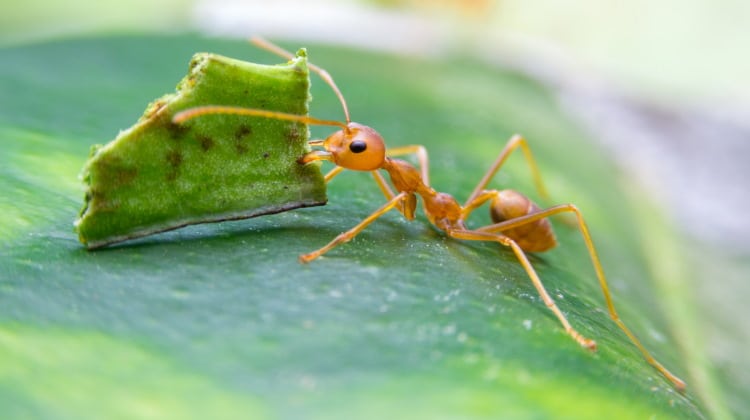
But before we look at the unbelievable lives of the Leaf Cutter Ants, let’s first examine a few interesting facts about ants in general.
- The oldest known ant in the world was found preserved in amber and lived 100 million years ago in the Mid-Cretaceous period. It is called Sphecomyrma freyi.
- Though some ant species live in extremely large nests – and colonies can contain amazing numbers of ants such as the single supercolony of Formica yessensis on the Coast of Japan which is reported to have had an incredible 1,080,000 queens and 306,000,000 workers in 45 interconnected nests – others can be very small.
- Nests of Leptothorax tuberointeruptus on the British coast can consist of only one queen and 50 workers – this is so small they can exist in a space equivalent to 2 ten cent coins held apart by a few grains of sand.
- Ants in general are amazingly successful creatures. On the Ivory Coast in Africa there can be as many as 7,000 colonies of ants per hectare, with an average of around 2,850 ants per colony. This adds up 20,000,000 ants per hectare or 2,000 per square metre.
- Some scientists have estimated that if you weighed up all the animals in the Amazon Basin, ants would make up about 30% of the total. Though they are not this successful everywhere, it is considered that they might make up as much as 10% of the total animal biomass of the world.
The Leaf Cutters (Fungus Farmers)
Some of the most amazing and fascinating ants in the world are the South American Leaf Cutter Ants (Attines).
There are 202 known species of Attines and all are fungus culturers or gardeners. The more advanced genera cut leaves from living plants in order to feed their fungus gardens, hence their vernacular or common names of ‘Leaf Cutters’ or ‘Fungus Gardeners’.
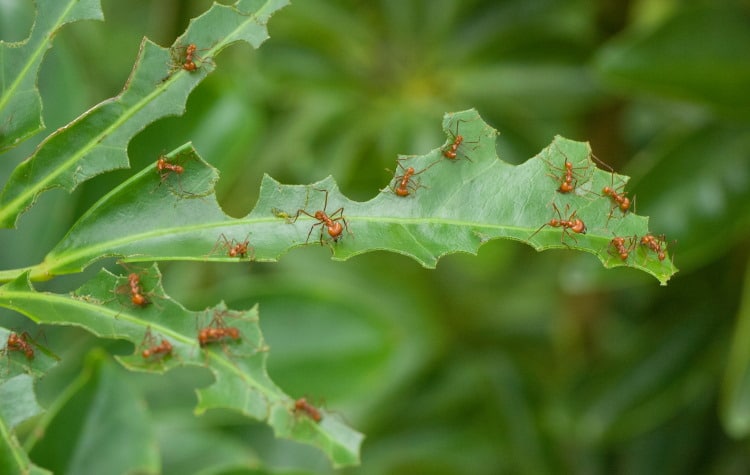
The different Attine species grow a variety of fungi on various substrates and feed themselves and their larva exclusively on the products of the fungi.
They can be divided into three different groups, depending on the kind of substrate they use and on the degree of polymorphism (having many forms) exhibited by the workers.
Primitive forms such as Cyphomyrmex remosa are monomorphic (i.e. the workers are all the same basic size) and they use insect droppings and pieces of dead plant material as the substrate for their gardens. Their nests are small with only a few hundred workers, who clean the floor area of the nest with their tongues before building a garden on it. They culture a yeast like fungus and feed on the bromatia.
Transitional forms are exemplified by species of Trachymyrmex. They build larger nests and use fallen flowers and fruit as well as insect frass (droppings specifically insect ones) to feed their gardens, though they are still basically monomorphic.
The more advanced types, though they may use dead vegetation to get the first garden in a new colony going, all use fresh cut vegetation after that. They go to far greater efforts to ensure a mono-culture of their desired fungus than the less evolved species. They all have polymorphic workers and the nests of some species can contain well over 500,000 workers.

The construction of a fungus garden begins with the swabbing clean of the floor where it is going to be. Then the first plant material is brought in and cut into little pieces by the media workers. Each piece of leaf is licked clean over its entire surface by the minima and media workers; this helps remove fungal spores.
Antibiotics such as myrmacacin are released by the ant’s mandidbular glands to help ensure that endophytic (inside the leaf) fungi do not compete with the ants cultured fungi.
Next the leaf is built into the garden, which is sculptured to contain many furrows and cavities where the brood is kept.
Once in place, the leaf piece is fertilised by an anal secretion of the ant which contains some proteases (protein degrading enzymes) which the fungus lacks, and then inoculated with several pieces of mycelium (the long thin bits of the fungi which you normally do not see because they are under the ground in macro fungi).
Most of this finer worker is done by the minim workers which are the smallest the three or four sizes of workers you can find in most Leaf Cutter ant nests.
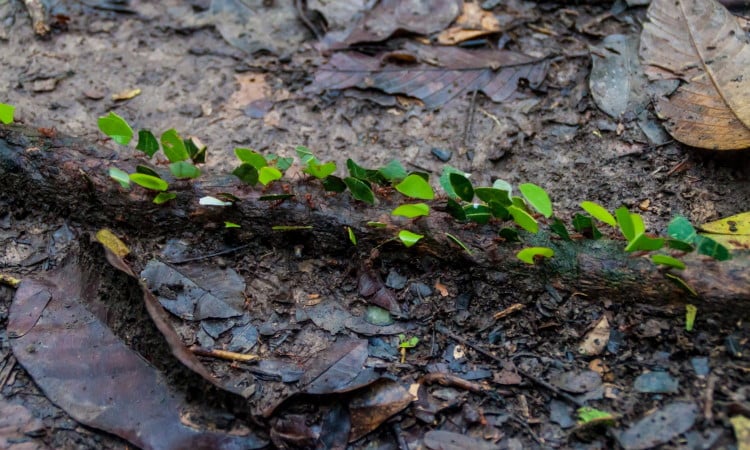
For genera such as Atta and Acromyrmex, an individual garden will be about 10-12 cms in diametre and have a life span of 3 to 4 weeks – it will produce gongylidia on which the ants and their larvae feed. During this time it is scrupulously cared for by the workers and any foreign fungi which develop are carefully removed and thrown out of the nest, or on to a garbage dump.
A leaf cutter ant nest will contain many gardens in various stages of use and may be quite large. A large nest can reach several metres (up to about 6) down into the ground and contain dozens of individual gardens. Different species of ant tend to use different plants as substrate, i.e. Atta texana uses grasses where Atta cephalotes uses the leaves of trees.
The fungus used by these higher species is believed to be Attamyces bromafiticus. It is completely dependent on the ants for its propagation and the ants are completely dependent on the fungus for their food.
Such is the extent of this amazing mutualism, that the fungus has never been found outside of an Attine nest and the gynes all take a small sample of the fungus with them in a special pouch under their chin (called a buccal cavity) when they go on their nuptial flight, so that they will be able to start new gardens after they are mated.
Final Thoughts
There is much more of interest to the leaf cutter ants that I haven’t have time to put here, like the fact that they have special soldiers that are larger than all the workers, but which don’t seem to do much.
Or the fact that a lot of workers that go out foraging take a hitching minima worker with them, that rides back on the piece of leaf they bring back to the nest with them.
I would recommend to anybody to have a closer look at these amazing creatures.
Lastly, perhaps now you’d like to learn about the bee wolf.


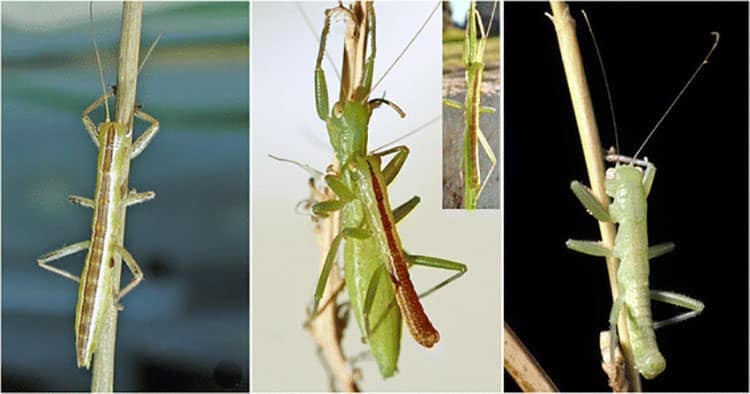

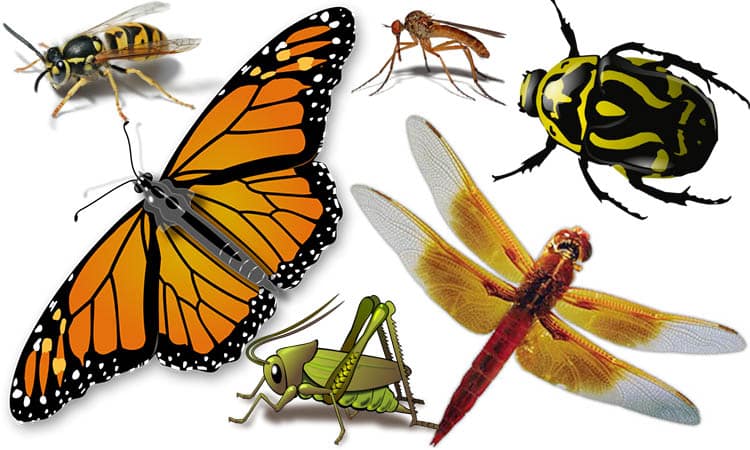

After reading this article, I feel like I have been missing this leaf cutting ant saga in my life!